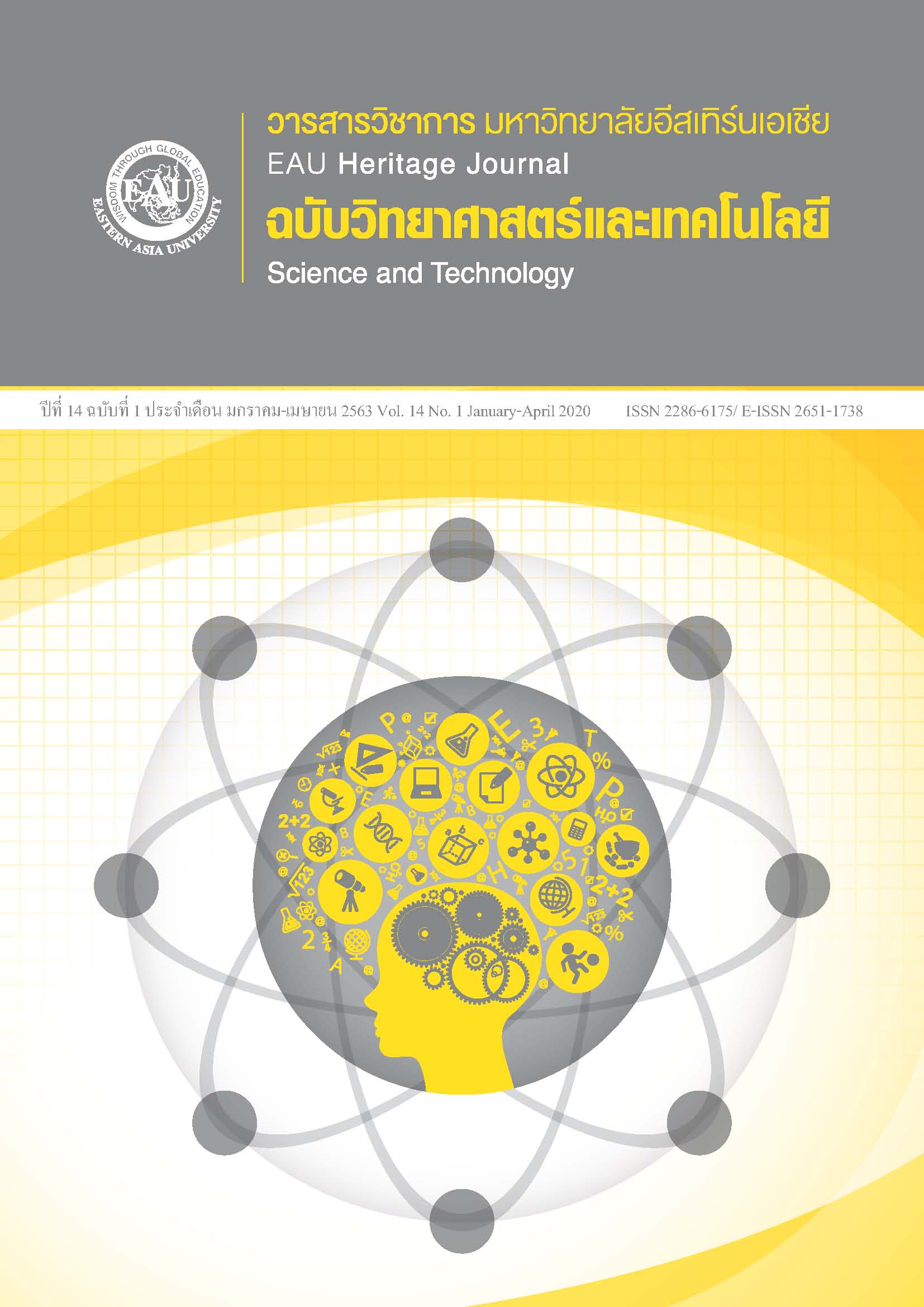การใช้ระเบียบวิธีไฟไนต์เอลิเมนต์ช่วยออกแบบการแลกเปลี่ยนความร้อนสำหรับการควบคุมไอระเหยของแก๊ส
คำสำคัญ:
การแลกเปลี่ยนความร้อน, สัมประสิทธิ์การถ่ายเทความร้อนรวม, สารอินทรีย์ระเหยง่ายบทคัดย่อ
การออกแบบการแลกเปลี่ยนความร้อนสำหรับการควบคุมไอระเหยของแก๊ส ใช้ของไหลที่มีอุณหภูมิต่ำมาแลกเปลี่ยนความร้อนกับไอระเหยของแก๊สที่มีอุณหภูมิสูงให้ต่ำลงจนถึงจุดที่ไอระเหยเปลี่ยนสถานะจากแก๊สกลายเป็นของเหลว เพื่อนำกลับมาใช้ได้ใหม่ และควบคุมปริมาณการปล่อยสารอินทรีย์ระเหยง่ายตามที่กฏหมายกำหนด จากการออกแบบแบบจำลองการทำงาน กำหนดอุณหภูมิน้ำ 25, 20, 15, 10, 5 °C และอุณหภูมิของเอทานอล 41 °C ของแบบจำลองการแลกเปลี่ยนความร้อน สำหรับวัสดุที่ใช้คือ ทองแดง เหล็ก และสแตนเลส ผลลัพธ์ของการจำลองการแลกเปลี่ยนความร้อนที่วัสดุคือ ทองแดงทำให้อุณหภูมิของเอทานอลลดลงมากที่สุด มีค่าเท่ากับ 17.36 ที่อุณหภูมิน้ำ 5 และทำการจำลองการทำงานของอุณหภูมิน้ำที่ 5 °C และความเร็ว 0.01, 0.02, 0.03, 0.04, 0.05 m/s ผลลัพธ์ที่ความเร็ว 0.05 m/s สามารถนำไปใช้ในการแลกเปลี่ยนความร้อนได้ดีที่สุด โดยอุณหภูมิของเอทานอลมีค่าเท่ากับ 12.34 และสัมประสิทธิ์การถ่ายเทความร้อนรวมมีค่าเท่ากับ 877.3 w/m2.°C จากผลการจำลองการทำงานด้วยโปรแกรมคอมพิวเตอร์สำเร็จรูปสามารถนำไปใช้ในการแลกเปลี่ยนความร้อนจากสถานะไอระเหยของแก๊สให้เปลี่ยนสถานะเป็นของเหลวได้ เป็นไปตามทฤษฎีและสมมุติฐานการวิจัย ซึ่งสามารถนำไปใช้เป็นข้อมูลในการออกแบบ และแนวทางผู้ที่สนใจพัฒนาต่อไปได้
เอกสารอ้างอิง
Reference
Bunnasa, S. (1997). Study of parameters and simulation of heat loss systems from silica furnaces by double-layer heat exchangers. Master of Engineering Thesis, King Mongkut's University of Technology. (in Thai)
Dechaumphai, P., & Thornton, E.A. (1982). Improved finite methodology for integrated thermal-structural analysis, NASA CR-3635. Washington DC: NASA.
Dechampai, P., & Wanasopak, N. (2012). Numerical methods in engineering. Bangkok: Chulalongkorn University. (in Thai)
Hansopa, N., & Benjapiyaporn, J. (2011). Heat transfer effectiveness of concentric tube heat exchanger with coiled wires. Master of Engineering Thesis, Khon Kaen University. (in Thai)
Kanansoon, S. (2014). Heat transfer between water and water mixed with suspended solids in heat exchangers. Master of Engineering Thesis, Rajamangala University of Technology Thanyaburi. (in Thai)
Sutham, M. (2010). Design and construction of heat exchange demonstration equipment. Master of Engineering Thesis, King Mongkut's University of Technology Thonburi. (in Thai)
Memorial, C. (2003). Convection convection in pipes with finned spiral inserted inside. Journal of Khon Kaen University 8(2), 66-7. (in Thai)
Munithangkul, S. (2001). Selection criteria for heat exchanger selection for waste heat recovery in the industry. Master of Engineering Thesis, King Mongkut's University of Technology. (in Thai)
Naphon, P. (2004). Theoretical and experimental study of heat transfer characteristics of coiled pipe heat exchanger. Doctor of Engineering Thesis, King Mongkut's University of Technology Thonburi. (in Thai)
Nuntaphan, A. (2000). Performance analysis of heat pipe heat exchanger using binary working fluids. Thonburi: King Mongkut’s University of Technology Thonburi. (in Thai)
Phongratsamee, U. (2012). Design of coiled feeder water heaters for radiant heat radiators flowing through one way. Master of Engineering Thesis, Mahanakorn University of Technology.(in Thai)
Sukchai, T., & SirikasemSuk, S. (2011). Study of heat exchanger studies of coiled condenser coils. the conference of Mechanical Engineering Network of Thailand, Krabi (pp. 1-13). Krabi: Mechanical Engineering Network of Thailand. (in Thai)
Sukkasem, A. (2007) Study of heat transfer of cylindrical fins. Master of Engineering Thesis, Srinakharinwirot University. (in Thai)
Suwakrai, C. (2007). Numerical and experimental analysis of heat transfer and flow characteristics in a spiral tube. Master of Engineering Thesis, Srinakharinwirot University. (in Thai)
Thanasri, T. (2011). The study of the experiment of finned coil spring heat exchangers. Master of Engineering Thesis, King Mongkut's University of Technology Thonburi. (in Thai)
Toolthaisong, S. (2011). The ratio of the pipe size that affects the effectiveness of a two-layer heat exchanger. Journal of Khon Kaen University, 38(2), 139-146. (in Thai)
Cha Bua Noi, T., & Phannucharoenwong, N. (2018). Effect of input variable changes on heat exchange efficiency of shell and tube heat exchanger prototype: To be used instead of the fuel vapor control unit. Master of Engineering Thesis, Mechanical Engineering, Faculty of Engineering, Khon kaen University. (in Thai)
Kalayaprasit, N. (2018). The impact of the characteristics of baffles that affect the thermal efficiency and pressure values in the shell and tube heat exchanger systems. Master of Engineering Thesis, Mechanical Engineering Faculty of Engineering, Thammasat University. (in Thai)







